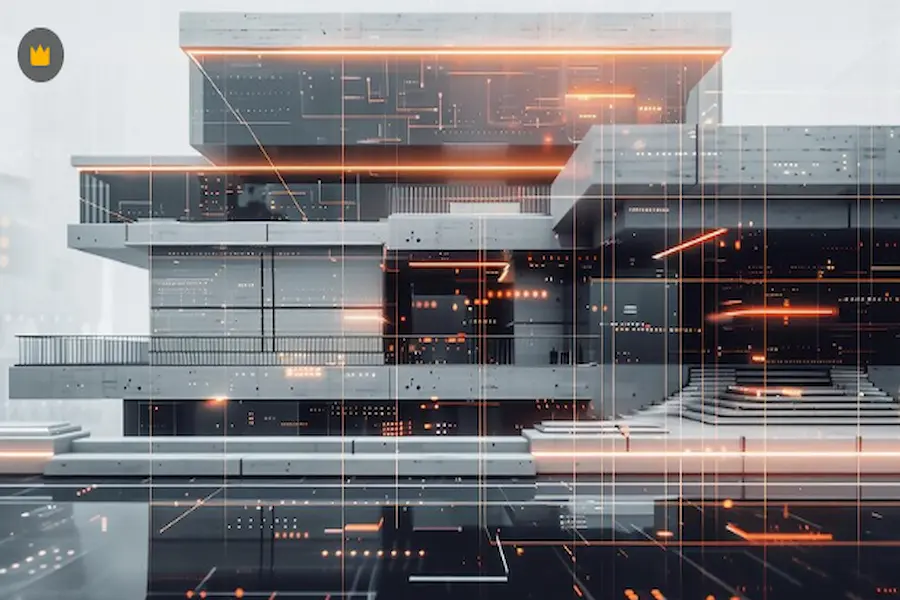Building technology has radically changed how we approach construction, transforming the entire industry. The shift from hand-drawn blueprints to sophisticated digital tools marks one of the most significant improvements. Initially, construction relied heavily on manual labor and traditional methods, but advancements in technology have brought greater efficiency, accuracy, and speed to the process.
A major advancement has been the introduction of computer-aided design (CAD) software. CAD allows architects and engineers to create highly detailed, three-dimensional models of buildings before construction begins. This technology helps visualize every aspect of the project, enabling better planning, reducing errors, and cutting waste. Additionally, innovations in materials like high-performance concrete, energy-efficient insulation, and composite materials are significantly improving building durability and energy efficiency.
Moreover, there’s been a notable shift toward sustainable building materials. Low-carbon, energy-efficient materials are now commonly used, helping to reduce buildings’ environmental impact. From carbon-neutral construction techniques to renewable materials, this shift is laying the groundwork for future generations to enjoy eco-friendly, durable buildings.
Smart Homes and Automation
When it comes to building technology, smart homes stand out as one of the most exciting developments. By integrating various devices through the Internet of Things (IoT), homeowners can control everything from lighting to security systems and even heating remotely. This technology not only offers convenience but also improves energy efficiency and security, two important priorities for modern living.
For example, smart thermostats learn user preferences and automatically adjust room temperatures, saving both energy and money. Similarly, advanced security systems featuring cameras and motion sensors can detect unusual activity, alerting homeowners instantly. As the cost of these systems continues to decrease, smart homes are becoming more accessible to a wider audience.
I personally use a smart thermostat, and I can’t imagine going back to a traditional system. The real benefit comes from the money it saves on energy bills, especially during peak seasons. Similarly, voice assistants like Amazon Alexa and Google Assistant are now integral parts of the smart home experience, enabling users to control lighting, temperature, and entertainment systems with just a few words. This level of automation brings convenience, comfort, and efficiency into everyday life.
Sustainable Building Tech
Sustainability is a key focus in today’s construction industry, and it’s becoming an urgent necessity. With the pressing threat of climate change, the demand for energy-efficient and eco-friendly buildings has never been more important. Fortunately, Building Tech is playing a pivotal role in reducing the construction industry’s carbon footprint while improving the performance of buildings.
Technologies like energy-efficient windows, solar panels, and green roofs are helping to reduce the energy needed to run buildings. Solar panels, for instance, have become far more affordable and efficient, allowing buildings to generate their own power and decrease their reliance on the grid. Additionally, advanced insulation materials such as spray foam, fiberglass, and cellulose are minimizing heat loss, which cuts down on energy consumption and reduces utility bills.
Sustainability goes beyond just energy efficiency. It also encompasses water management. Smart plumbing systems that detect leaks can stop water wastage, while greywater recycling allows water from sinks and showers to be reused for irrigation. These innovations conserve valuable resources and help reduce the environmental impact of buildings. Building Tech is an essential consideration in any modern build or renovation project, and it’s a choice that saves both resources and costs.money and the environment in the long run.
3D Printing in Construction
3D printing has emerged as a game-changer in construction, transforming how buildings and components are made. What started as a tool for small-scale projects is now being used to construct entire building components, which has the potential to drastically reduce time, labor, and costs.
By printing components layer by layer, 3D printing allows for faster and more cost-effective construction. Homes that once took months to build can now be constructed in a matter of days. Additionally, the materials used in 3D printing are often more sustainable than traditional construction materials. The precision of 3D printers ensures that components are not only structurally sound but also tailored to fit together seamlessly, minimizing errors during assembly.
The potential of 3D-printed homes is enormous. These homes not only offer affordable housing solutions but are also highly resilient, thanks to the exact precision of the printing process. The ability to customize these homes based on individual needs or environmental factors further expands the possibilities for 3D printing in construction.
Robotics and Automation in Construction
Robotics and automation are rapidly transforming the construction industry by increasing efficiency, reducing human error, and improving safety. Building Tech is enabling robots to perform a range of tasks, from bricklaying to welding, and even working in dangerous environments that were previously unsafe for human workers.
Drones, for example, are valuable tools in construction. They provide aerial surveys and real-time updates on the construction process, allowing project managers to oversee the site from above and identify issues quickly. Autonomous vehicles are also making an impact by transporting materials to and from job sites, which helps streamline workflow and reduces the need for manual labor.
Robotic arms, often used for precision tasks such as painting and welding, can work for long hours without fatigue, ensuring consistent quality. These robots also help reduce the risk of injuries on construction sites, as they take on the more physically demanding tasks. By incorporating robotics and automation through Building Tech, the construction industry can work more efficiently while providing safer environments for workers.
Augmented Reality (AR) and Virtual Reality (VR) in Construction
Augmented Reality (AR) and Virtual Reality (VR) are playing a transformative role in construction by enhancing the design, planning, and construction phases. With VR, stakeholders can step into full-scale 3D simulations of buildings before construction even begins. This immersive experience allows them to explore every detail, identify potential design flaws, and make necessary adjustments—ultimately saving time and reducing costly mistakes. This is a prime example of how Building Tech is revolutionizing the construction industry.
On the other hand, AR overlays digital information onto the physical world. Contractors and construction teams can use AR to view detailed building plans directly on the construction site, allowing them to make real-time adjustments and ensure the work is done to specification. This integration of Building Tech ensures more precise execution on-site.
Both AR and VR improve collaboration by allowing different teams to engage with the same digital model, ensuring that everyone is on the same page. These technologies also provide valuable training opportunities, as workers can practice tasks in a virtual setting before working on actual sites. With their ability to streamline workflows, reduce errors, and improve safety, Building Tech like AR and VR are set to become essential tools in the construction industry.
Building Information Modeling (BIM)
Building Information Modeling (BIM) is an indispensable tool in modern construction. BIM is a digital representation of a building’s physical and functional characteristics that allows architects, engineers, and contractors to collaborate using a single model. This centralized approach ensures that all stakeholders are working from the same set of information, which improves communication and reduces mistakes. As part of Building Tech, BIM enhances the overall construction process.
BIM helps optimize workflows by providing real-time updates to all parties involved, enabling quick design changes and adjustments. It is particularly useful for cost estimation, project scheduling, and detecting conflicts within the design before construction begins. Building Tech solutions like BIM streamline project management and improve efficiency. BIM has become an integral part of modern construction, especially as it integrates with technologies like robotics and 3D printing, making projects more cost-effective and efficient.
Artificial Intelligence (AI) in Building Tech
Artificial Intelligence (AI) is rapidly becoming a game-changer in building tech, offering innovative solutions to optimize performance, reduce costs, and improve overall building operations. AI analyzes large datasets to provide actionable insights on everything from design optimization to energy efficiency.
AI can optimize architectural designs by analyzing the best material choices or the most energy-efficient layouts. In smart buildings, AI systems learn from patterns of occupancy to fine-tune heating, lighting, and cooling, leading to significant energy savings. AI is also used in predictive maintenance, identifying when equipment is likely to fail, allowing for timely repairs before costly breakdowns occur.
As more buildings integrate AI into their operations, the efficiency of building management will continue to improve, contributing to smarter, more sustainable buildings.
The Future of Building Tech
The future of building technology is incredibly promising, and the next few years will likely see the continued integration of AI, robotics, 3D printing, and sustainable technologies into construction practices. These innovations are set to make the construction process even more efficient, cost-effective, and sustainable.
The integration of renewable energy systems like solar panels, wind turbines, and geothermal heating will continue to play a significant role in reducing buildings’ carbon footprints. Modular and prefabricated construction methods will also become more refined, cutting down on both time and costs.
As cities become smarter, advanced technologies such as IoT and AI will help create more connected, efficient, and sustainable urban environments. The rise of smart cities will rely on smart buildings, automated transportation, and real-time data, all working together to improve the quality of life for their residents.
Advanced Construction Materials
The construction industry is embracing advanced materials that offer durability, sustainability, and energy efficiency. Materials like self-healing concrete, transparent aluminum, and eco-friendly insulation are helping create buildings that last longer and have a minimal environmental impact.
For example, self-healing concrete contains bacteria that repair cracks, extending the lifespan of structures. Transparent aluminum offers the strength of metal with the clarity of glass, creating a more durable yet aesthetically pleasing material. Other innovations, such as recycled steel and eco-friendly insulation, are reducing waste and improving the performance of buildings.
These advanced materials ensure that the buildings of the future will be more resilient and better equipped to withstand the challenges of climate change.
Conclusion: Building Tech as a Catalyst for Change
The future of building tech is exciting. Innovations like smart homes, sustainable building materials, and AI-powered systems are already reshaping the construction industry. These technologies are improving efficiency, sustainability, and safety, and they hold the potential to create smarter, more sustainable environments for future generations.
As we continue to embrace new technologies in construction, the industry will not only become more efficient and cost-effective but will also contribute to a greener, more sustainable world. The integration of renewable energy systems, advanced robotics, and modular construction methods promises a future where buildings are smarter, more resilient, and more eco-friendly.
ReadAlso:11 Revolutionary Advances in AC Tech: Smarter, Energy-Efficient Cooling Solutions

